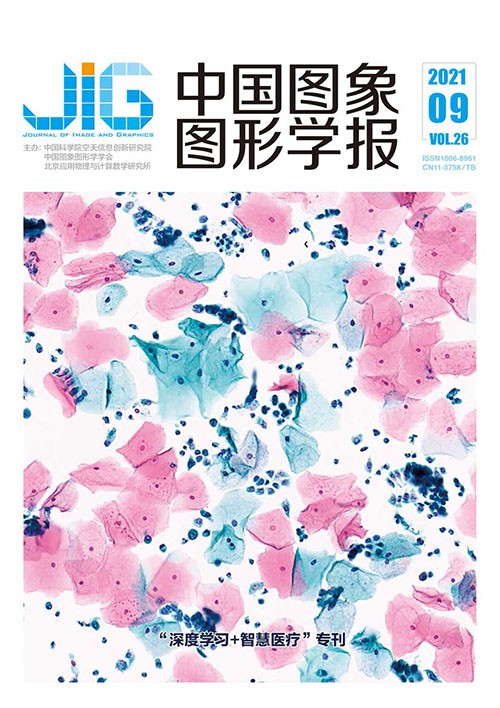
U-Net网络医学图像分割应用综述
周涛1,2, 董雅丽1, 霍兵强1, 刘珊1, 马宗军3(1.北方民族大学计算机科学与工程学院, 银川 750021;2.北方民族大学图像图形智能处理国家民委重点实验室, 银川 750021;3.宁夏医科大学总医院骨科, 银川 750004) 摘 要
病灶精确分割对患者病情评估和治疗方案制定有重要意义,由于医学图像中病灶与周围组织的对比度低,同一疾病病灶边缘和形状存在很大差异,从而增加了分割难度。U-Net是近些年深度学习研究中的热点,为医生提供了一致性的量化病灶方法,一定程度上提高了分割性能,广泛应用于医学图像语义分割领域。本文对U-Net网络进行全面综述。阐述U-Net网络的基本结构和工作原理;从编码器个数、多个U-Net级联、与U-Net结合的其他模型以及3D U-Net等方面对U-Net网络模型的改进进行总结;从卷积操作、下采样操作、上采样操作、跳跃连接、模型优化策略和数据增强等方面对U-Net网络结构改进进行总结;从残差思想、密集思想、注意力机制和多机制组合等方面对U-Net的改进机制进行总结;对U-Net网络未来的发展方向进行展望。本文对U-Net网络的原理、结构和模型进行详细总结,对U-Net网络的发展具有一定积极意义。
关键词
U-Net and its applications in medical image segmentation: a review
Zhou Tao1,2, Dong Yali1, Huo Bingqiang1, Liu Shan1, Ma Zongjun3(1.College of Computer Science and Engineering, North Minzu University, Yinchuan 750021, China;2.The Key Laboratory of Images and Graphics Intelligent Processing of State Ethnic Affairs Commission, North Minzu University, Yinchuan 750021, China;3.Department of Orthopedics, General Hospital of Ningxia Medical University, Yinchuan 750004, China) Abstract
Medical imaging has been a proactive tool for doctors to diagnose and treat diseases via the qualitative and quantitative analyses based on non-invasive lesions. Medical images have been interpreted via computer tomography (CT), X-ray, magnetic resonance imaging (MRI) and positron emission tomography (PET). The barriers of medical image segmentation need to be resolved due to low contrast amongst the lesion, the surrounding tissue and blurred edges of the lesion. Labeling manually for hundreds of slices of organs or lesions has been quite time-consuming due to anatomy of the human body and shape of lesions. Manual labeling has intended to high subjective and low reproducibility. Doctors have been beneficial from a automatically locating, segmenting and quantifying lesions. Deep learning has been used widely in medical image processing. Deep learning-based U-Net has played a key role in the lesions segmentation. The encoding and decoding ways has made U-Net structures simply and symmetrically. Features extraction of medical images has been realized via convolution and down-sampling operations. The image segmentation mask via the transposed convolution and concatenation has been interpreted. A small-sized dataset has achieved qualified medical image segmentation. U-Net has been summarized and analyzed on the four aspects:the definition of U-Net, the upgrading of U-Net model, the setup of U-Net structure and the mechanism of U-Net. Four research areas have been proposed as below:1) the basic structure and working principle of U-Net via convolution operation, down sampling, up sampling and concatenation. 2) U-Net network model have been demonstrated in three aspects in the context of the number of encoders, multiple U-Net cascades and other models combined with U-Net. U-Net based network have been divided into two, three and four encoders further in terms of the amount of encoders:Y-Net, Ψ-Net and multi-path dense U-Net. Multiple U-Nets cascade has been categorized into multiple U-Nets in series and multiple U-Nets in parallel based on the cascades mode of multiple U-Nets. In addition U-Net has improved the segmentation performance on the aspects of dual tree complex wavelet transform, local difference method, level set, random walk, graph cutting, CNNs(convolutional neural networks) and deep reinforcement learning. The upgrading of U-Net network structure have been divided into six subcategories including image augmentation, convolution operation, down-sampling operation, up-sampling operation, model optimization strategies and concatenation. Image enhancement has be divided into elastic deformation, geometric transformation, generative adversarial networks (GAN), Wasserstein generative adversarial networks (WGAN) and real-time image enhancement further. The convolution operation has been improved via padding mode and convolution redesign. The padding mode mentioned has adapted constant padding, zero padding, replication padding and reflection padding and improvements to dilated convolution, inception module and asymmetric convolution. The down-sampling has been improved via max-pooling, average-pooling, stride convolution, dilated convolution, inception module and spatial pyramid pooling. Several up-sampling improvements have illustrated simultaneously via sub-pixel convolution, transposed convolution, nearest neighbor interpolation, bilinear interpolation and trilinear interpolation. Model optimization strategies have been divided into two aspects in detail of activation function and normalization, the improvements of activation function includes rectified linear unit(ReLU), parametric ReLU(PReLU), random ReLU(RReLU), leaky ReLU(LReLU), hard exponential linear sigmoid squahing(HardELiSH) and exponential linear sigmoid squashing(ELiSH), and normalization method. The improvements have been to shown based on batch normalization, group normalization, instance normalization and layer normalization. The concatenation based improvement has been one of the future research area. The current concatenation improvements have been mainly realized via attention mechanism, new concatenation, feature reuse and de-convolution with activation function, annotation information fusion from Siamese network. The improved mechanisms in the U-Net network have been emphasized based on residual mechanism, dense mechanism, attention mechanism and the multi-mechanisms integration. The segmentation performance of the network can be enhanced. The further four research areas in U-Net have been illustrated as below:1) the generalization of deep learning methods cannot be customized to fit the segmentation network for specific scenarios in the future. 2) Supervised deep learning models have required a lot of annotated images labeled for treatment. Unsupervised and semi-supervised deep learning models have been a vital research work further. 3) The low interpretability of U-Net network has lead the low acceptance in the mechanism of its operation.4) More accurate segmentation mask with fewer parameters has been obtained via good quality network structure. The precise manual segmentation has been so time-consuming and labor intensive. The simplified and quick semi-automatic segmentation has relied on the parameters and user-specified image preprocessing. The deep learning-based U-Net network has been segmented the lesions quickly, accurately and consistently. The structure, improvements and further research areas of U-Net network have been analyzed to the development of U-Net network.
Keywords
|



 中国图象图形学报 │ 京ICP备05080539号-4 │ 本系统由
中国图象图形学报 │ 京ICP备05080539号-4 │ 本系统由